Golf Cart GPS: How Slow Play Hurts Both The Player Experience And the Bottom Line
Slow play in golf is a hotly debated topic. Widely regarded as one of the most challenging aspects of the game among players from around the world, many have turned to golf cart GPS as a solution. Not only does slow play harm the player experience, but it also directly and indirectly affects the revenue of the golf course. With participation in golf at an all-time high, both courses and players share the responsibility of maintaining an acceptable pace of play; however, this is often easier said than done, especially without tools like golf cart GPS features.
No golfers want to sacrifice their precious time for five-hour (or longer) rounds, and courses battle the tricky challenge of balancing operational efficiency with player satisfaction, while trying to remain profitable. In this article, we’ll be exploring pace of play in detail, from looking at the standards set by the governing bodies and the reasons slow play occurs at the recreational level, to what can be done to combat the bane of all golfers.
Golf Cart GPS And Standard Pace Of Play Guidelines

The pace of play is the speed at which golfers make their way through the course. This means the time it takes from hitting the first shot on the first tee to sinking the last putt on the eighteenth green. The pace of play of a single group directly affects the pace of play of the rest of the field, so it’s an important aspect of the game that needs to be maintained.
It’s generally accepted among golfers that a round of golf should take between four and four and a half hours, but as no two courses are the same, this is not a hard and fast rule. The USGA has set out guidelines that encourage prompt play, where it is recommended that a shot should not take more than 40 seconds to complete. This, combined with the average length of a golf course as well as the average ability of a golf player, equates to around the four-and-a-half-hour mark.
In practice, this can get hard to enforce or manage from a course’s perspective, and it’s a problem many facilities face. Course marshals are seen as the “bad guys”, and golfers dislike being told to speed up for the time that may have been lost. Fortunately, resolving these situations has become a lot easier thanks to golf cart GPS systems, amongst other things, but more on that a bit later.
Why Slow Play Is So Hotly Debated In Golf
Slow play can lead to a lot of frustration for a lot of players as it is a disruption to the flow on the course, creates bottlenecks, and can be seen as disrespectful to fellow players and fans on a professional level. For recreational players in a fast-paced age, time has become valuable, and they simply cannot afford to spend up to or more than five hours playing a round.
In recent years, we’ve increasingly seen professionals post five to six-hour rounds due to the extensive time pros take in their preparation to hit their shots. While it’s understandable that these players have a lot on the line, practices such as these can lead to a decline in viewership and stagnate growth.
Some people believe that slow play issues are merely individual, while others are of the view that course management and professional tours bear the responsibility. There are numerous reasons why slow play may occur, which lead to many conversations and debates around the topic.
Golf Cart GPS: Why Pace Of Play Is A Challenge For Golf Courses
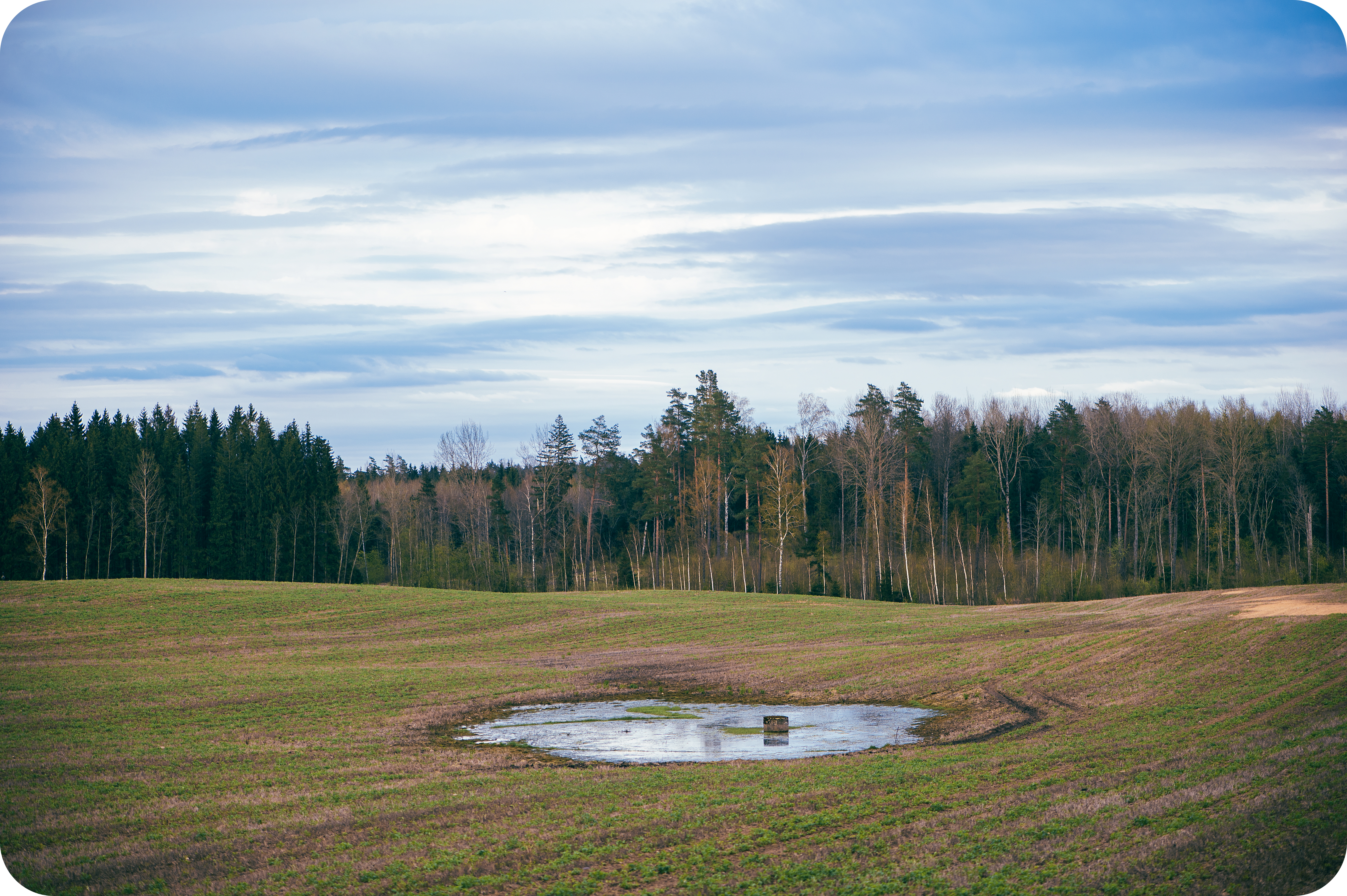
Golf courses, and more specifically their managers, find managing pace of play challenging due to the ripple effect it can have on numerous other factors. When the pace is slow, player satisfaction goes down, which leads to a negative course image and reputation. This causes participation at the course to decrease, which in turn ultimately affects the revenue. Oftentimes, it can be as little as one slow group that affects the speed of the entire field.
On the other hand, courses can be set up to challenge players but ultimately prove to be too demanding, which would affect the pace of play across the board. Weather conditions can also play a factor, and while this is out of the control of golf course managers, they are still responsible for setting the course up accordingly. Any of these factors, or a combination of them, can be a cause of slow play.
The challenge golf courses face in this regard is that once slow play occurs, how do they assist in getting the field back on pace again? Traditionally, the golf course manager or course marshal would need to physically head out on the course, find the out-of-position group, and urge them to speed up their play. This is labor-intensive, time-consuming, and often results in players being dismayed.
Reasons For Slow Pace Of Play
There can be a near-endless number of reasons for slow play, but generally, slow play can be attributed to five main areas:
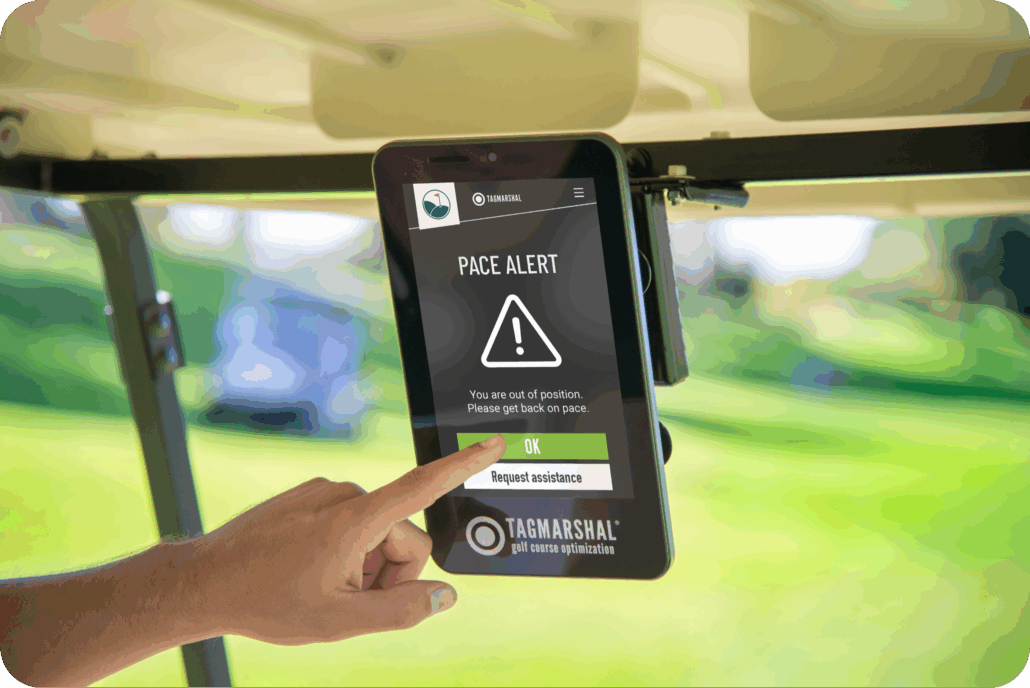
- Course design
- Course maintenance
- Course/golf club management
- Player ability
- Player behavior
Course design is one of the biggest factors that influences the pace of play, but it is the most difficult to change. Nor should a course change to conform to any sort of arbitrary, universal pace standard, or any arbitrary ‘pace standard’ that might exist. Any course design is as unique as the time it would take to play it; therefore, there isn’t really a universal standard time for a course as a whole, only an appropriate standard time for each course. Determining what that is is the challenging part.
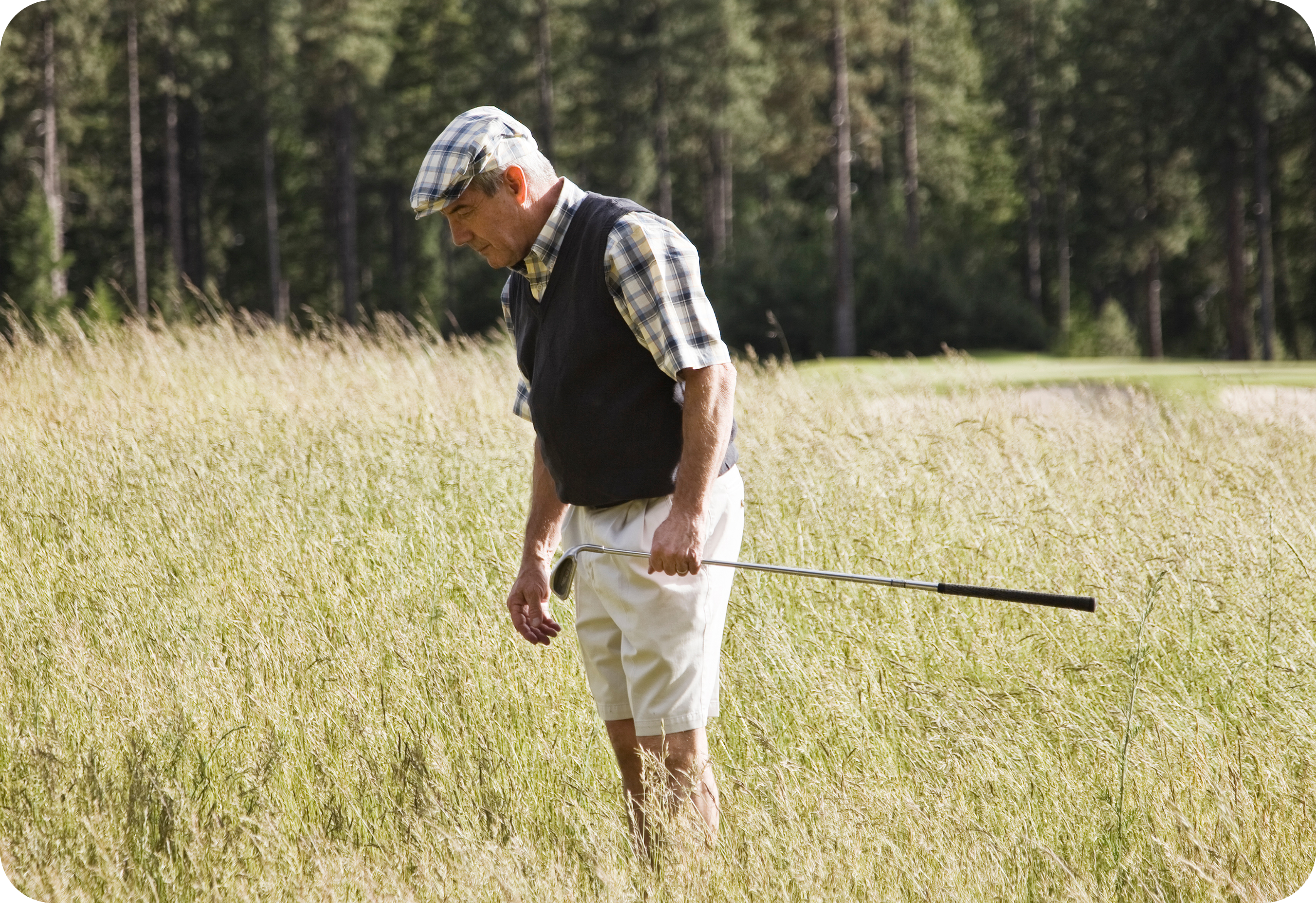
Course maintenance, on the other hand, is something that can be more easily adjusted, depending on what is required. Having thick rough and tall trees in areas where the majority of players will end up, like 180-200 yards off the right of the fairway from the tee, is a surefire way to slow down pace on your own accord. Golf club management comes into the conversation when a club tries to squeeze in as many tee times (often too many!) on a peak day in order to generate more income. That is all good and well – a golf course is a business after all – but there should be a good balance, and finding that balance is key.
Player ability can affect pace of play negatively and positively. Players on the PGA Tour aside, it’s only logical that low-handicapped players will get through the course quicker than high-handicapped players, as they take fewer shots. It’s imperative that newcomers and high-handicappers be cognizant of etiquette that will speed up play, like playing ‘ready golf’ and picking up instead of finishing the hole when they’re out of scoring range.
Player behavior is no doubt the continuous scapegoat for slow play whenever the debate arises, sometimes both with and without reason. That being said, there are many small things all players can do to speed things up, which would add to improving the pace over the course of a round.
These are things like planning your shot when other players are busy with theirs, parking the carts on the correct side of the green so you can swiftly move to the next tee, keeping ball searches as short as possible, playing provisional shots when you’re unsure, minimizing practice swings, and not marking your ball on putts when it’s not necessary.
How Tagmarshal Golf Cart GPS Technology Can Help
Tagmarshal is the leader in golf course optimization, and through our range of features, we help golf courses enhance the player experience while ensuring that clubs operate at their full potential. By addressing the issues that contribute to pace of play, or rather the lack thereof, Tagmarshal enables courses to take control of and manage the factors that most often lead to delays, whether that is slow groups, bottlenecks, tee time management, or course maintenance. Here, we’ll look at numerous slow play contributors and how we tackle them directly.
The Problem: Course Design
While Tagmarshal can’t do much about the course design itself, Advanced Reporting facilitates a deeper understanding of pace for the course and, thereby, the available capacity at specific times during the week. This means that courses will know how long a round should take during specific periods and manage groups accordingly.
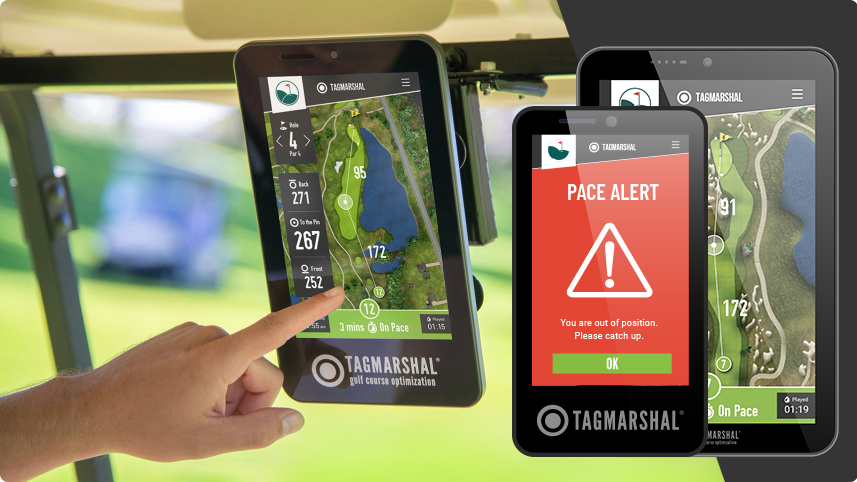
The Problem: Yardage and Decision-Making
Many golfers’ approach to their shots includes having to find yardages with a rangefinder or yardage books, which can be time-consuming. Tagmarshal’s 2Way screens show to-the-pin yardages on each shot, so there is no need to ponder any indecisions. In addition, WindTag gives your players hyperlocal, real-time wind speed and direction, and can even recommend club selection, taking any guesswork out of the equation and saving a heap of time.
The Problem: Slow Groups
Just one slow group is all it takes to disrupt an entire field out on the course. With Tagmarshal’s golf cart GPS Pace Disruptors feature, operators can set unique parameters for what would be a slow group and intervene before it affects the rest of the players, in a non-intrusive way. This keeps everyone moving at a reasonable pace.
The Problem: Status of the Pace of Play
The Tagmarshal golf cart GPS Live Map enables operators to have a full line-of-sight view of their course at any time, from anywhere. This eliminates the physical and time-consuming need for manpower to head out on the course to determine the pace of play. Colored icons on the map show which groups are keeping pace and which aren’t, and differentiates between those affecting other groups and those that aren’t.
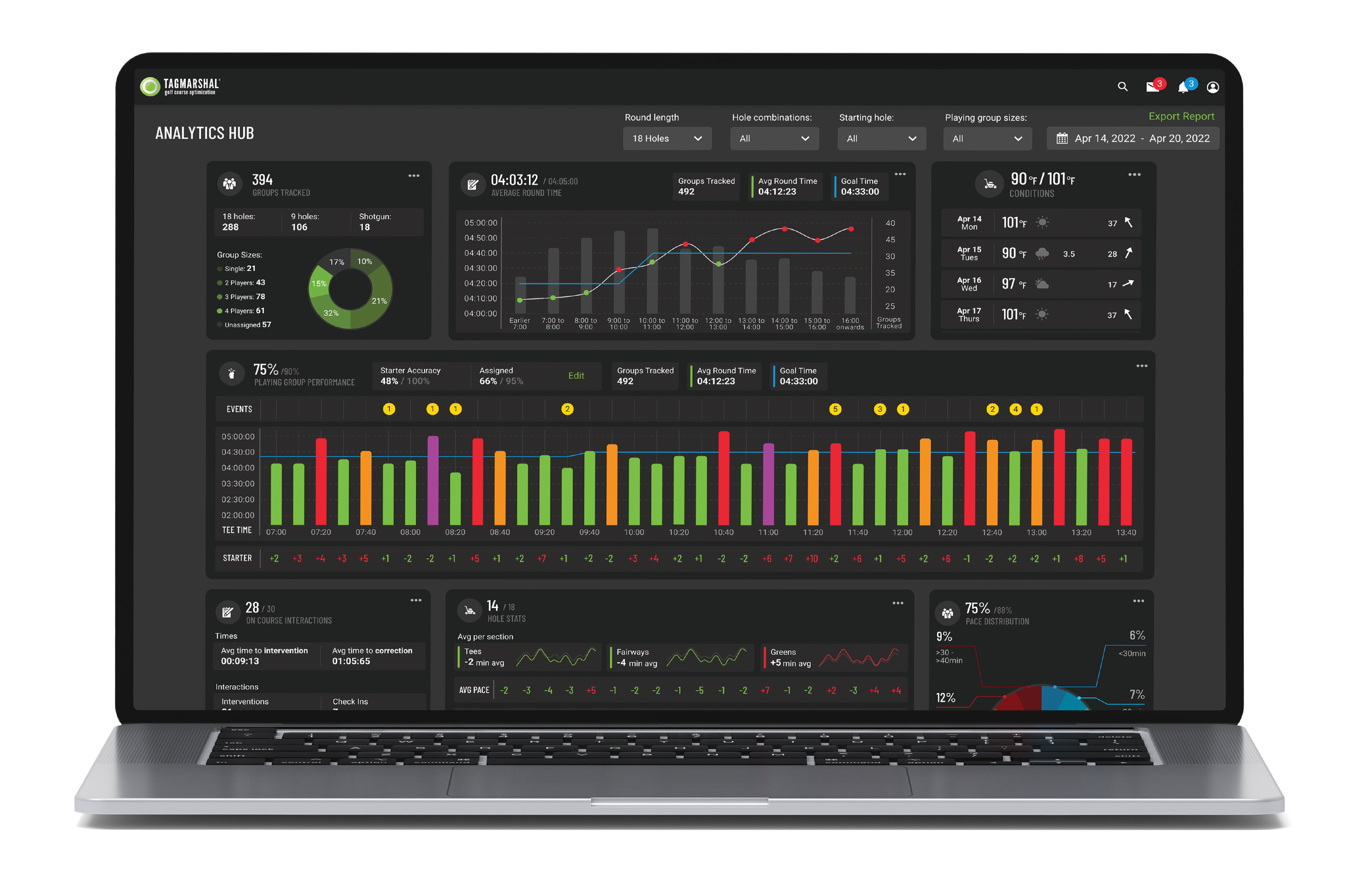
The Problem: Inefficient Golf Course Management
Tagmarshal’s Analytics Hub is one of the most powerful components of Tagmarshal’s golf cart GPS offerings. It brings together a host of data sets across numerous aspects of golf course management. The Analytics Hub is the most effective way to measure a course’s pace and flow of play meaningfully, and as a result, data-driven decisions can be made to enhance the player experience and increase course revenue.
Golf Cart GPS Conclusion
If you or your golf course is ready to make pace of play issues a thing of the past, we’re here to help. Tagmarshal’s golf cart GPS and optimization solutions are designed to help you take control of slow play. Our technology delivers real-time visibility, data-driven insights, and proven results that improve efficiency and, more importantly, profitability. Get in touch with the Tagmarshal team today and discover how your course can operate smarter, delivering a better experience for every golfer who visits!
GIVE YOUR TEAM THE TOOLS TO DELIVER EXCEPTIONAL RESULTS
Watch Demo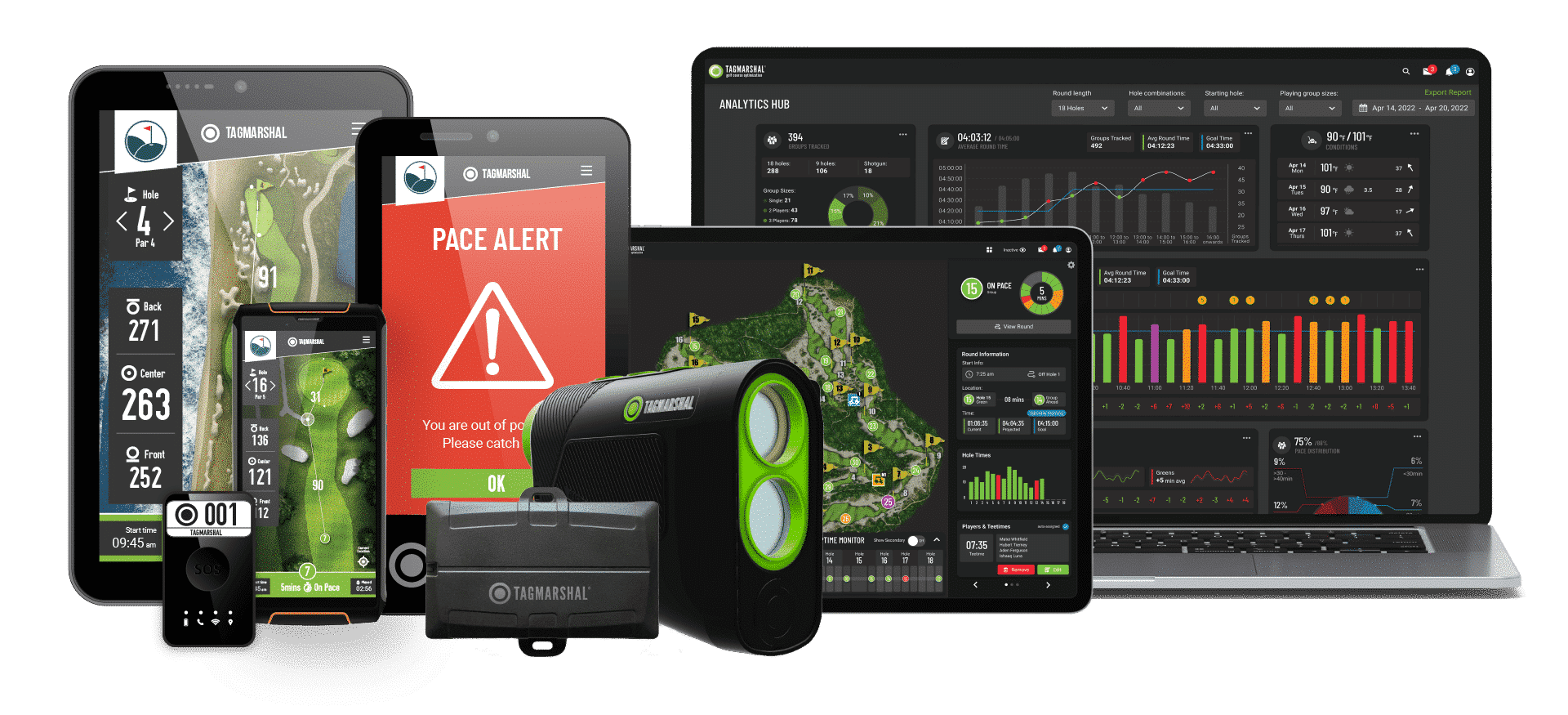
ABOUT TAGMARSHAL
Tagmarshal, the market leader in on-course optimization technology, provides courses with full, real-time operational oversight and reporting, giving golf operators the tools to manage pace and flow of play effectively, resulting in enhanced player experiences, increased efficiency through automation, and additional revenue generation.
Tagmarshal’s technology has collected over 100 billion data points from more than 95 million tracked and improved rounds of golf and has relationships with in excess of 900 partners, including Hazeltine, Whistling Straits, Baltusrol, Fieldstone, Bandon Dunes, The Old Course at St Andrews Links, Serenoa and Erin Hills.
Tagmarshal partners with several golf management groups, private, daily fee, public and resort courses, including 50 of the Top 100 courses, as well as many $40-$60 green fee courses, which are seeing excellent results using the system.
 WATCH DEMO
WATCH DEMO